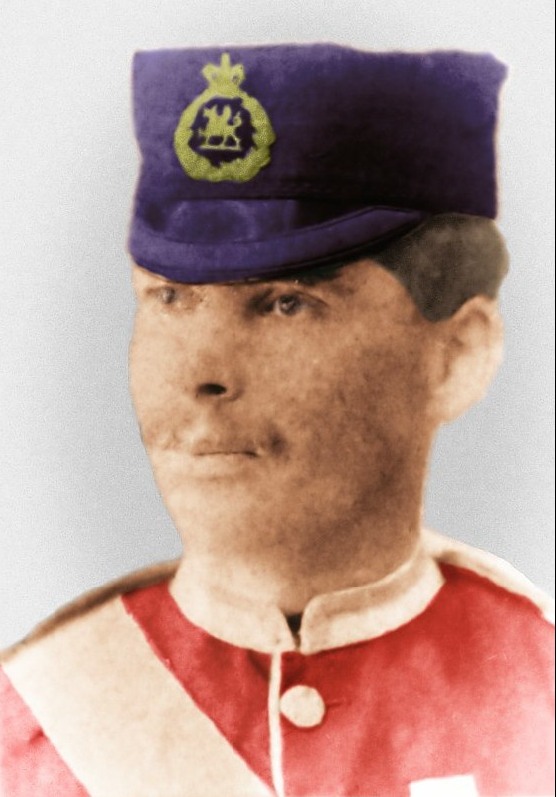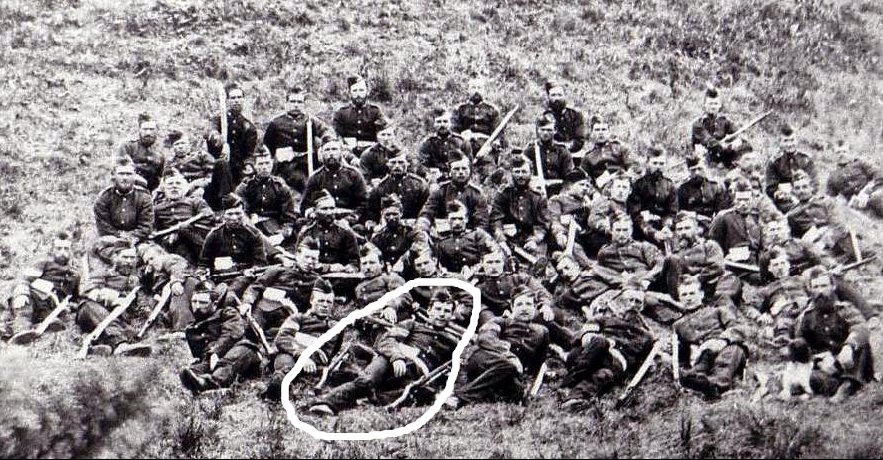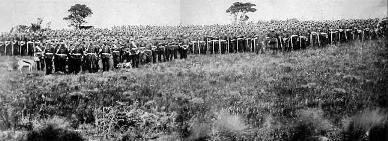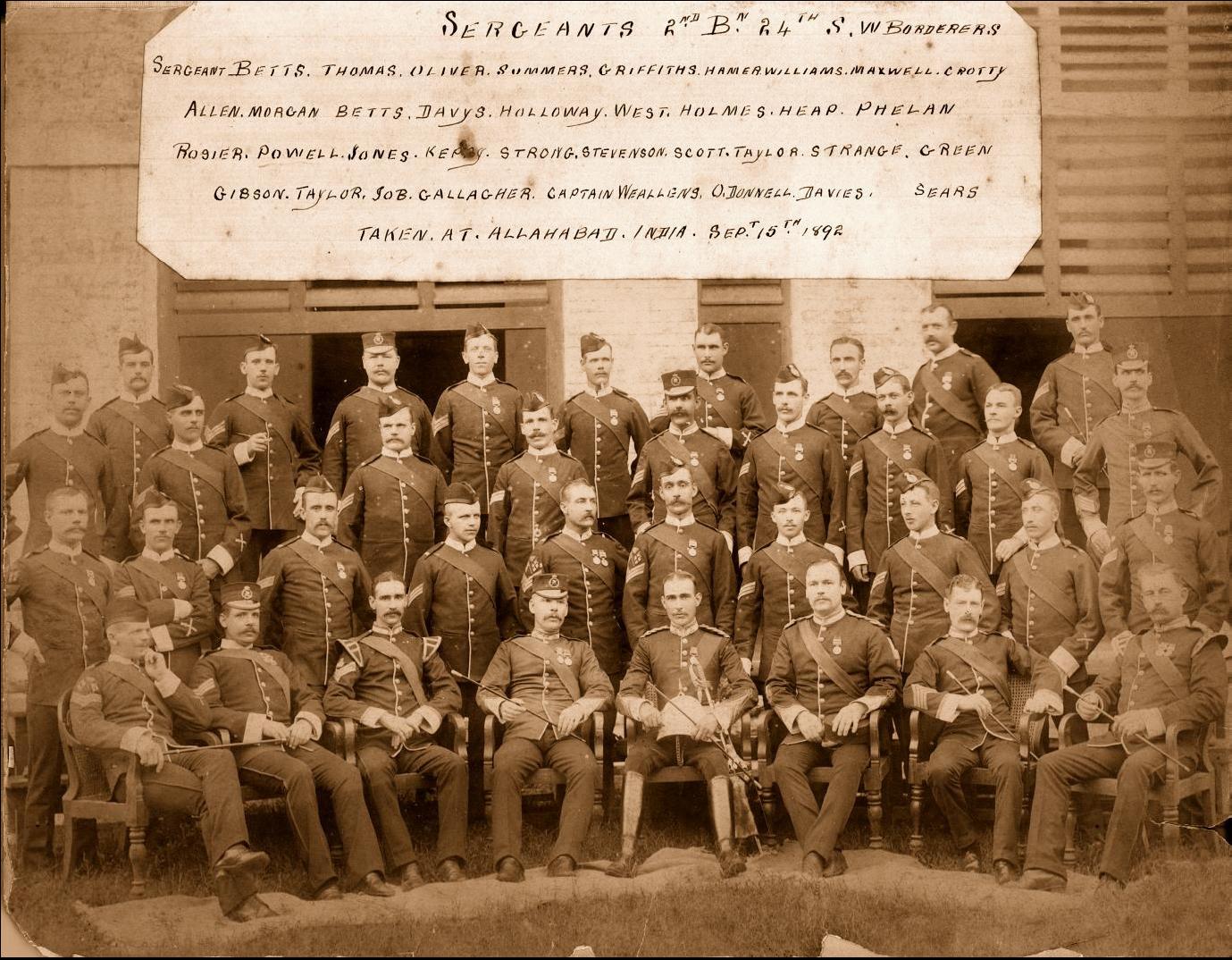THE QUIET SERGEANT

Henry Edward Gallagher 1855-1931
A Rorke’s Drift Man
This is the story of one young man who was amongst a small but very brave band of British soldiers who were the defenders at the battle of Rorke’s Drift, Natal, South Africa. Most people are aware of the film ‘Zulu’; this depicts the battle and although the facts are not 100% factual it is very good entertainment. Amongst that small garrison was Sergeant Henry Gallagher the senior Sergeant of ‘B’ Company 2nd/24th Warwickshire Regiment of Foot. Henry’s parents were named as Henry Gallagher born in Eire (Republic of Ireland)
Henry Gallagher Senior was recorded as being a Merchants Clerk and was married to a Mary Kennedy on the 7th February 1854 at Killenaule Parish Church witnessed by ones James Walshe and Ellen Fitzgerald.
Henry Junior was born in about March 1855 at a place called Killenaule, County Tipperary, Eire. He was baptised on the 28th October 1855; he had a sister although very little is known of her.The early part of Henry’s life in Eire is surrounded a bit in mystery. Some family stories tell the story that he witnessed a fire at the family home, a farm or small holding which had been reported as being claimed by the Catholic Church, for the education he had received from them upon the death of his parents. Henry was a bright young man and quick to learn. As he grew older Henry got employment as a Clerk and it is not certain why he chose to leave his home country of Eire to join the British Army in Liverpool.
Henry had his enlistment medical conducted by H. D. Devlin Surgeon Major of the Army Medical Department on the 14th March 1874. Following a second medical he was attested at Liverpool on 16th March 1874 and joined 25th Brigade at Brecon on the 17th March 1874. His papers show that his admitted age was 19 years 0 months, he was 5ft. 6 1/4ins. tall, a fresh complexion, with amber eyes and dark brown hair, his religion is noted as Roman Catholic. He was given the regimental number 25B/ 81.
During the following year he did his basic training and by March 1875 he had been promoted to Corporal, probably getting rapid promotion due to his education in Eire as a young man and obtaining a 2nd Class Certificate of Army Education on the 14th December 1875. Henry found himself in Dover and further promotion to Lance Sergeant followed in January 1877. Henry married on the 7th April 1877 to Caroline Maria Stanley a spinster of 6 Dover Street, Charton, Dover, Kent. Caroline was the daughter of a North Sea Pilot who was reputedly the Pilot who accompanied Captain Webb on the first ever-recorded cross Channel swim. They eventually had six children all the three sons all had careers in the Army.
June 1877 found Henry in Chatham, Kent a further promotion followed to Sergeant in October 1877. In February 1878 he was ordered to join the troopship HMS Himalaya bound for South Africa with twenty four Officers, eight Staff-Sergeants, thirty eight other Sergeants, forty Corporals, sixteen Drummers and seven hundred and fifty Privates.
|
.jpg)
|
|
HMS Himalaya
|
They docked at Simons Bay to replenish supplies and finally reached East London South Africa on the 9th March. Here they were ordered onto trains that took them to King Williams Town. Fighting, mainly skirmishing, took place in the Perie Bush during April and May with the amaXhosa in what is now known as the Last Kaffir War. During this time the 2/24th were stationed at Mount Kempt.
Number 25B/81 Sergeant Henry Gallagher found himself again on the move and was transported by mail boat to Durban and was landed by whaler onto the beaches. A march with the rest of the 24th Warwickshire Regiment towards Zululand, as the central column of Lord Chelmsford’s invading force. His wife Caroline together with other wives remained at Pinetown, Durban.
In January 1879 he was at Rorkes Drift as senior Sergeant of ‘B’ Company 2/24th 2nd Warwickshire Regiment. He had been rather aggrieved that the rest of the column had been ordered forward into Zululand and was camped at Isandlwana. He had to stay at Rorkes Drift with the rest of ‘B’ Company to wait for relief from Helpmekaar. On the morning of 22nd January along with Colour Sergeant Bourne and three other NCO’s he was on the hill behind the Mission Station ‘The Shiyane’ (Oskarsberg) rifle and gun fire could be heard coming from the camp at Isandlwana and smoke and muffled battle noise was heard. Following their own observations and reports from the column a hasty defence was constructed of mealy bags, biscuit boxes and wagons at the Drift. Henry with several other sharp shooters was in charge of the section of mealy bag wall on the south side between the two wagons and the hospital building, Fred Hitch was placed on the hospital roof as a look out. This part of the Drift was to take the first attack of about four hundred Zulu. These were first seen by Fred Hitch who informed Henry, Henry then turned to the Officers behind him and in his own words called out,
 |
|
The defenders of Rorke’s Drift (Henry circled)
|
‘Here they come as thick as grass and as black as thunder’. He stated that his little band of shooters first fired at eight hundred yards but totally failed to make any shots count, He also at this stage felt terrified but after firing a few more shots the fear left him only to return after the battle. During the battle the continuos firing of the Martini caused the barrel of the rifle to get very hot. Henry stated that during the darkness hours they could be seen glowing red, he had to tear the sleeve of his tunic of to wrap around the barrel to stop his hands burning. The breech of the Martini also expanded allowing black powder to flash back, this caused a tattooing effect on the side of Henry’s right cheek and nose and he had this blue/black mark for the rest of his life.
In the later part of 1879 he was moved to Utrecht and took no further part in hostilities in the Anglo Zulu conflict. January 1880 he joined the troopship HMS Orontes at Durban bound for Gibraltar where he served for 294 days before returning to home service.
|

|
|
2nd 24th Warwickshire Regiment
|
In January 1881 he was promoted to Colour Sergeant. His first child Caroline Lillian was born at Brecon on the 17 August of the same year. During this time the Cardwell Reforms were taking place and the 2nd/24th 2nd Warwickshire Regiment became the 2nd Battalion South Wales Borderers Colour Sergeant Henry Gallagher was ordered to the 1st Battalion and given a new regimental number of SWB/1590. He remained in the U.K. for the next 2years and 61 days. For his service in South Africa he received the South Africa Campaign Medal with Clasp 1877-8-9.January 1883 saw Henry with his small family again bound for foreign lands, this time to India. On the 17th June his second child Henry Edward was born in Secunderabad, later to serve in the Royal Engineers. A third child William Alfred was born in Madras on the 13th October 1885, he too was to serve with the Royal Engineers later transferred to the Royal Signals as a Major.
|

|
|
Henry in India
|
The 9th of May 1886 saw the expanding family posted to Burma Violet Elizabeth was born on the 29th January 1888 in Toungou. Henry was awarded the India General Service Medal with clasp Burma 1887-89 Henry and his family spent a total of 2 years and 185 days in Burmah only to return to India 10th March 1888 On the 9th January 1889 Henry was once again promoted this time to a Warrant Officer rank of Sergeant Major. Another addition was made to the expanding family on 10th February 1890 at Ranikhet Daisy Dorothea was born. A period of 5 years and 6 days was spent in Indian service before on the 19th of October 1892 he was posted to Aden on the troopship HMS Serapis.
In Aden his records show that he was hospitalised for the first and only time of his service life with ulcers of the feet and spent close to 3 weeks under medical supervision. He arrived back in the U.K. 18th November 1893 and was stationed in Hilsea and then Gosport. On the 9th June 1895 Lawrence Stanley the last addition to the family was born, he was later to serve with the Royal Engineers finishing his army career as a Colonel in the Royal Artillery. After only a short 1 year 314 days the family were once again on their travels this time to Egypt on the 28th September 1895.
In Cairo, Egypt he was Garrison Sergeant Major a rank that in today’s army would be of a Regimental Sergeant Major. His next step would to have been commissioned as an Officer as he was now top of the Non Commissioned Officer tree. During his time as Garrison Sergeant Major in Cairo he was always very particular with regard to his turn out, his eldest daughter would always inspect him before duty to make sure that his turnout was immaculate with clean boots, no ‘blanko’ on his blue trousers and his medals gleaming. He was always aware of his short stature and held himself tall, he would not suffer fools gladly. It was at this time that he either lost or had stolen his issued medals. The thought from family knowledge is that they were stolen. As it was required that he would wear his Medals at all times whilst on duty this must have been a devastating blow. Henry is believed to have acquired another set of his two medals and is believed to have ‘bought or borrowed’ a set from a soldier of the same surname returning home via Egypt from the far east he then had them carefully engraved with his own number, initial and rank. There are to this day two sets known, one in the hands of a private collector bought by him in London at auction for £8,500 in 1991 (perhaps the originals) and another at the Royal Artillery Museum, Woolwich together with his Meritorious Service Medal.
Henry with his family returned to home shores on the 31 March 1897 for the last time and was discharged the service on the 10 May 1897 after a total of 23 years 56 days with the Colours of the British Army, he gave his intended residence as Borstal House 48 London Avenue North End Portsmouth. He only managed to be a civilian for one day either he or the Army felt that they needed each other and he was appointed as Barrack Warden at Coleworth Barracks, Hilsea and Alexandria Hospital and remained as such until 1911. On the 29th November 1910 he had been awarded the Meritorious Service Medal.
In retirement he lived happily with his wife Caroline at ‘Wistaria’, Augustin Road, Drayton. Hants. He enjoyed his garden and looking after his chickens. It is known that Fred Hitch VC used to visit and they would talk of the old days, on these occasions the grand children were ordered to stay away from the old soldiers, as their discussions were not for young sensitive ears. He was also known to protect his young charges from the bigger boys of the area and would come out of the house armed with a ‘Knobkerrie and chase them off. He also loved to take walks on the downs behind his house and when he had the grand children with him it was always known as campaigning and he would tell stories both imaginary and of his days in the army.
On the anniversary of the defence of Rorke’s Drift Henry used to become very remorseful and would want to be left on his own, he would sometimes have a few drinks to ease the pain of his memories, there was of course no counselling in those days. This was the time of ‘The British stiff upper lip’.
On the 17th of December 1931 on his way to bed and at the bottom of the stairs he died of a heart condition at the admitted age of 75 his occupation is recorded as Warrant Officer Army Pensioner.
He was buried at Christ Church, Portsdown, with semi-military honours. In attendance were a number of Officers, Warrant Officers and Men of the South Wales Borderers and wreaths were laid. Fred Hitch’s son Charles also attended and laid a wreath on behalf of the men of ‘B’ Company 2nd/24th 2nd Warwickshire Regiment from both deceased and still alive but all very old men. The press at the time reported his great military service. His wife Caroline died shortly after and rests with him.
25.08.03 Roger Lane (Great Grandson)
Copyright ©2003 Roger Lane